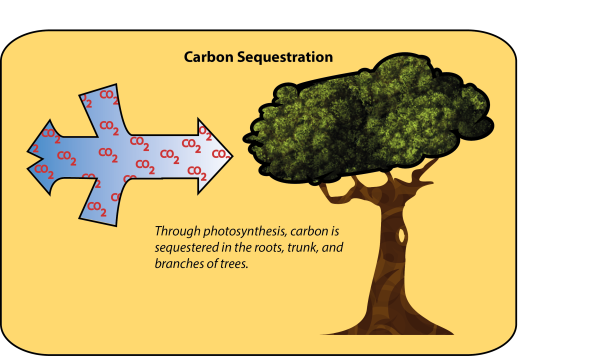Table of Contents
Carbon Sequestration
Carbon sequestration is the process of capturing atmospheric carbon and, most importantly, storing it for the long term.
Carbon dioxide (CO2) is the most abundant form of atmospheric carbon. As a “greenhouse gas”, CO2 also plays a major role in contributing to global climate change and is therefore the most common target for carbon sequestration. Carbon sequestration may also target methane (CH4), which is 25 times more climate-effective than CO21) . By capturing and storing these gases, this process slows down the accumulation of atmospheric and marine carbon, thereby reducing the rate of climate change.
Carbon sequestration can occur either naturally or as a result of direct human intervention. One example of direct human sequestration is geological sequestration, which involves the capture and subsequent injection of carbon into deep underground reservoirs. Natural carbon storage is often considered an Ecosystem Services (ES) and is most prevalent in biological processes such as tree growth. For example, by capturing carbon and converting it into biomass, trees effectively sequester carbon until they decay, or are burnt. Furthermore, harvesting of trees for use as a building material can extend the effective length of sequestration, as the carbon is then stored until the building material is destroyed.
Indicators
A common indicator for carbon sequestration is the amount of carbon sequestrated from the atmosphere per year (tC/ha/y). This amount can be quantified by a range of possible methods, spanning from the estimation of Net Ecosystem Productivity to the calculation of the change in biomass stock.
AlpES Carbon Sequestration Assessment
For the purposes of the AlpES Project, this ecosystem service is defined as “carbon sequestration by forests and bogs”. This extra piece aids in the assessment and mapping of the service by allowing evaluations for an ecosystem type to be subsequently modeled across the Alpine Space. Forests and bogs were selected, as they are the ecosystems with the greatest potential for carbon storage. As the specific methods of this assessment are finalized, they will be recorded here.
Within the project the provision dynamics of the ES CO2 sequestration by forests and bogs in the Alps were assessed by means of the following supply, demand and flow indicators:
- Demand: CO2 emissions (t CO2 ha-1 y-1 )
AlpES WebGIS Link
The AlpES Project quantifies and maps the ES of carbon sequestration for the Alpine Space. These maps, demonstrating the distribution and rates of CO2 sequestration, will be located here.
Additional Resources
- “A guide to CO2 sequestration” 2)
see also: Carbon (CO2) Sequestration AlpES Project Term
